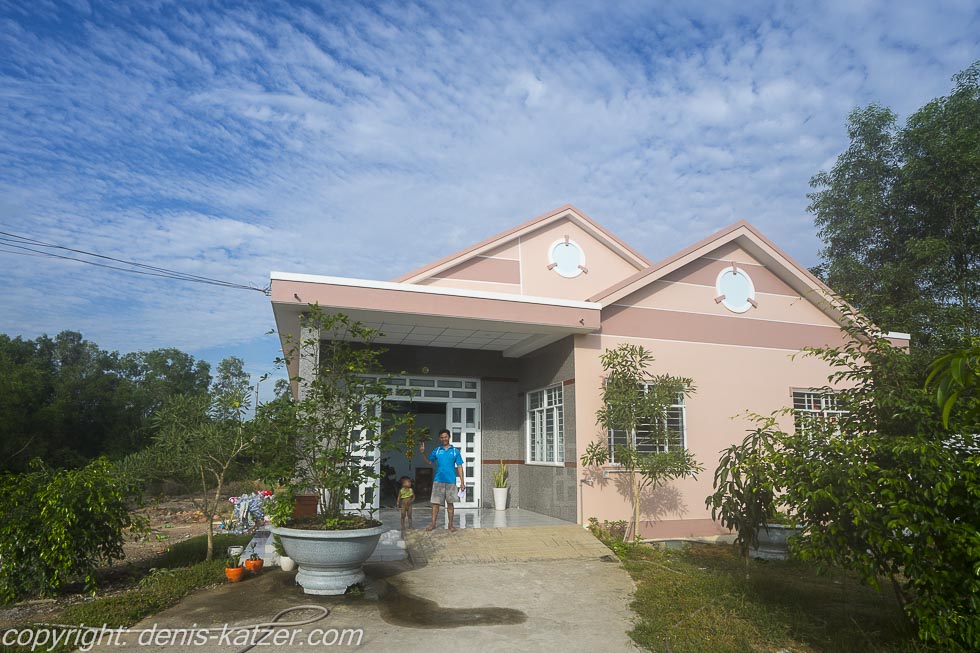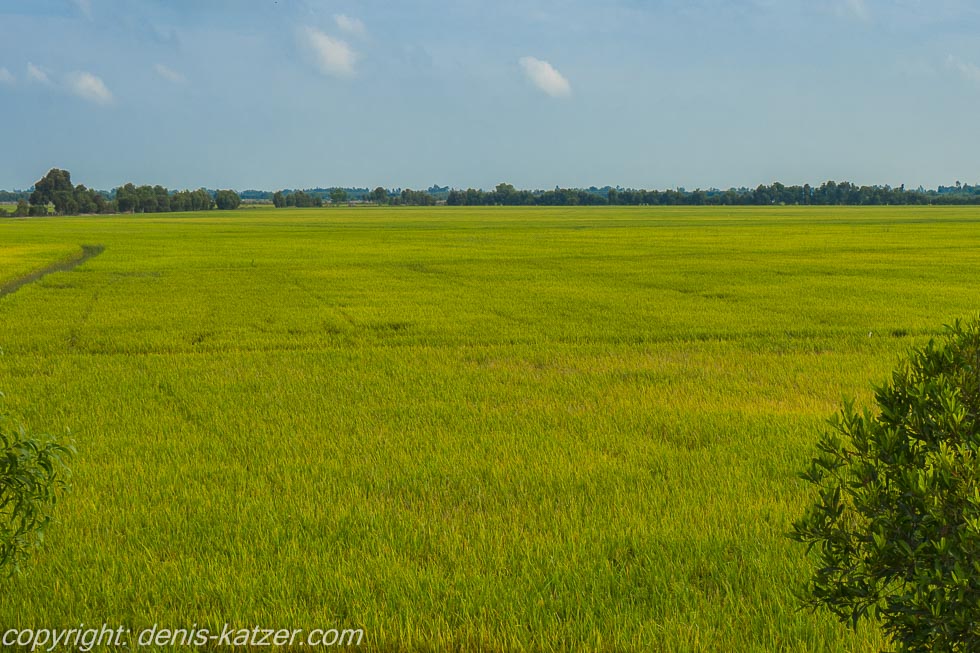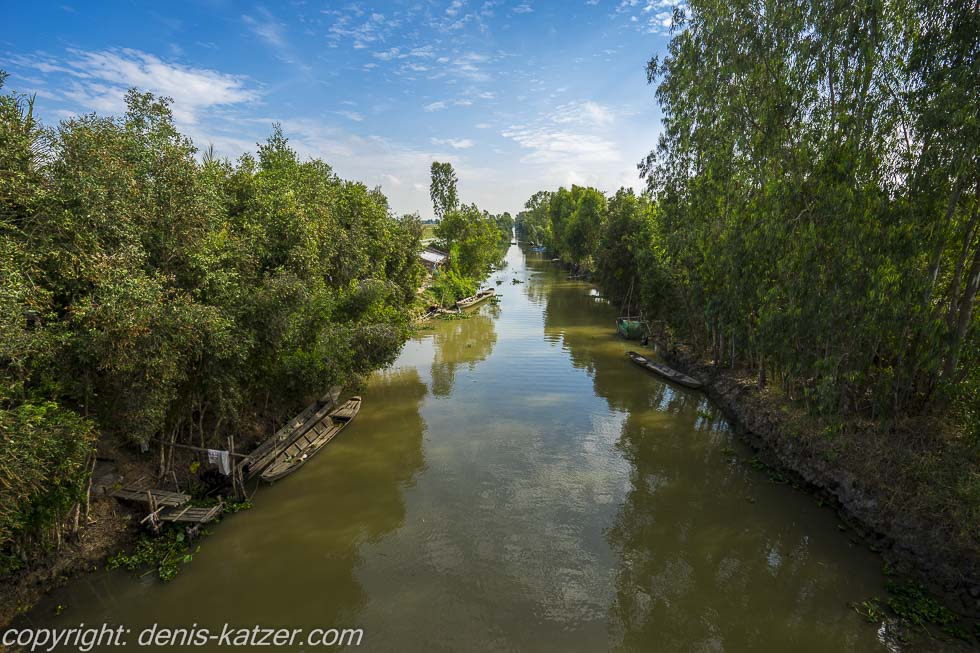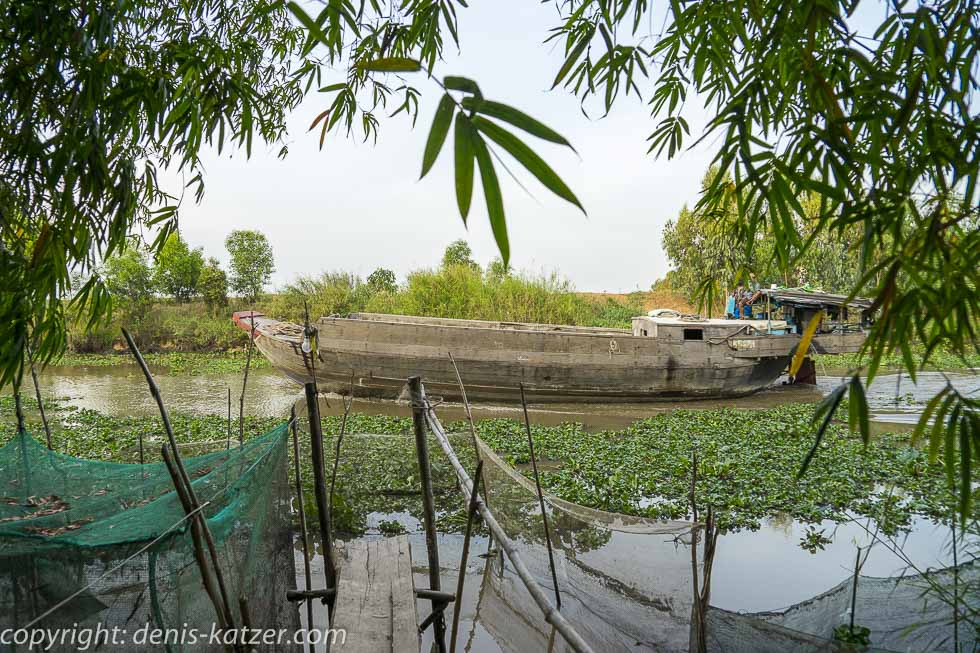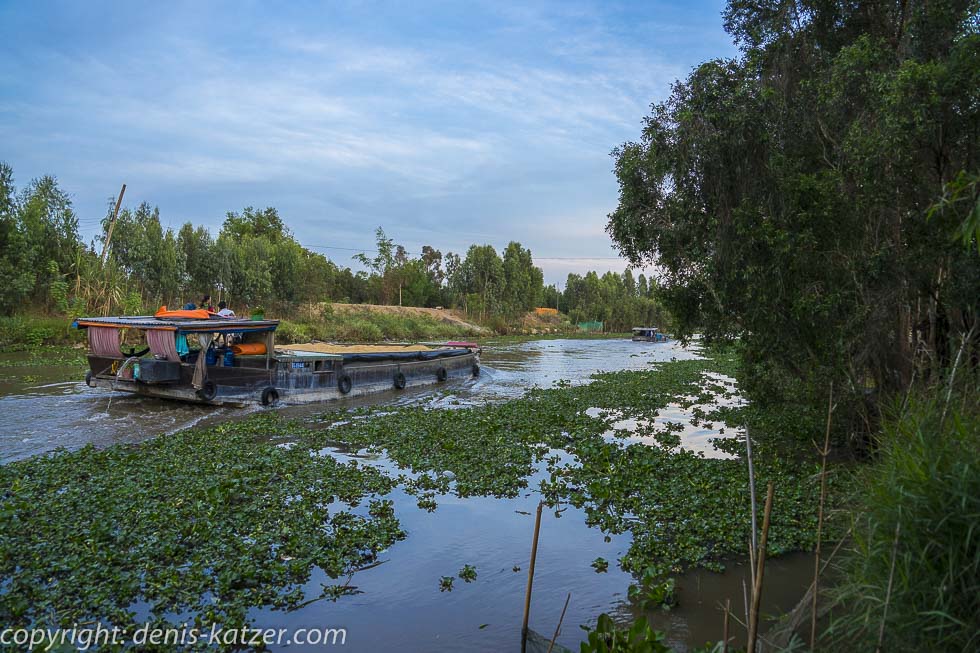
Mekong Delta
N 10°50'08.4'' E 105°40'12.5''
Date:
25.03.2017
Day: 634
Country:
Vietnam
Province:
Long An
Location:
Tân Hưng
Latitude N:
10°50’08.4”
Longitude E:
105°40’12.5”
Daily kilometers:
50 km
Total kilometers:
23,134 km
As the crow flies:
44 km
Average speed:
24.4 km/h
Maximum speed:
28.7 km/h
Travel time:
2:00 hrs.
Soil condition:
Asphalt
Maximum height:
10 m
Total altitude meters:
70.224 m
Altitude meters for the day:
70 m
Sunrise:
05:58 pm
Sunset:
6:08 pm
Temperature day max:
34°C
Departure:
7:00 a.m.
Arrival time:
11:30 a.m.
(Photos of the diary entry can be found at the end of the text).
While I load the bikes, Tanja goes to pay. Now the room no longer costs 110,000 (€4.51) as agreed yesterday afternoon, but 250,000 dong. (10,26 €) With extremely friendly words, the owner now apologizes for charging an hourly rate for her 24-hour hotel. We are appalled, do not pay and refer to their statement from yesterday. The woman’s face instantly freezes to ice and her words are suddenly no longer nice, but she shouts at me, pokes my upper arm with her fingers and demands her money at the top of her voice. I remain calm. Her husband rushes over and tries to calm his wife, who is running up and down the corridor like a frightened chicken. To avoid further escalation, I reach an agreement with the young and friendly landlord for 200,000 dong. (8,21 €). When Tanja gives him the money, he suddenly has a guilty conscience and hands us two bottles of mineral water. I’m just about to stow the presents in the saddlebags when the lodge owner comes running up again and gives us a whole pack of cleaning cloths. As we roll the bikes out of the lodge onto the narrow road, the man waves after us and says, “I hope they come back soon.”
My stomach is still grumbling. The bacteria also seem to have spread from me to Tanja. “How are you?” I ask as we drive side by side on the empty road. “I hope it doesn’t get any worse, but I think I can get through it today.” We are now in the middle of the Mekong Delta, a network of river arms that are in turn connected by canals. The approx. 39,000 km² area is growing by 80 meters a year due to the sediments that are constantly being washed up. Although there is not the slightest elevation in this region, the landscape of rivers, canals and huge rice fields is beautiful. Rice cultivation was only started during the French colonial period and the area under cultivation increased tenfold by 1930. Today, the fertile soil provides farmers with 16 million tons of rice in three annual harvests.
Apart from the heat, we enjoy the ride through the fertile alluvial land where intensive agriculture is practiced. We follow a straight road that is bordered by a canal on the left and right. Barges, smaller transport boats and longboats chug past us. Half-ruined wooden huts huddle on the narrow strip of earth between the road and the water. The inhabitants of this water world have small boats with which they use the numerous waterways, of which there are far more here than roads. We stop at one of the simple shelters to order a phở. Although we’ve only been on the road for 1 ½ hours and it’s only 8:30 in the morning, we feel groggy. “Phew, I don’t know what’s worse, the cold or this monkey heat?” “Neither is the best thing for a cyclist,” Tanja replies dryly. “What do your tummy aches do?” “They hurt.” “Hm, I’m still grumbling too. I wonder if they’ve given us spoiled food again somewhere,” I ponder, looking at what’s been prepared in the primitive kitchen, which consists of two dirty pots and a fire on the floor. Withered vegetables and pork sweating in the sun. “Don’t know if we should eat here?” I’m completely unsure. After some back and forth, we order a phở without meat. I sit down in the hammock and spoon up the delicious soup. Out of the corner of my eye, I watch the woman, her two children and the man, who are all under the corrugated iron roof, sheltering from the sun. Do they belong to the Cham people? Sunni Muslim rice farmers, who make up a small minority group here in the delta? Or do they belong to the Khmer, the former owners of the Mekong Delta, who now live as just another small minority group in Vietnam and, with 12 million inhabitants, are the largest ethnic group in the neighboring country. They certainly aren’t Hoa, I think to myself, because they don’t look Chinese. The Hoa belong to a significant minority that has been living in Vietnam for a long time. To this day, they have not really assimilated, isolating themselves and keeping to themselves.
“Denis! What’s wrong? You look so thoughtful.” “Have I actually just thought about which people these people here belong to?” “What’s going through your head?” “It’s probably because of the extensive documentation work,” I reply, because there are hardly any moments when I’m not thinking about the problems caused by environmental pollution, the people who live in these countries, which religions they follow and a whole lot more. “And what god do you think they worship?” Tanja asks after I tell her about my thoughts on the minorities living here. “How should I know that?” “You can see the Muslims’ religious affiliation. I’ve seen a few women wearing headscarves and men wearing Muslim caps in the Delta.” “Yes, of course, you can see it on the Muslims, but the clothing of the other ethnic groups doesn’t give it away. I only know that there are many Buddhists, Catholics and the Muslims you mentioned, as well as Cao Đài and Hòa Hao.” “Cao Đài and Hòa Hao? What’s that?” “Caodaism was founded in the south of this country in 1926. From what I’ve read, the founder of the religion received revelation through spiritualist sessions. This faith teaches the transmigration of souls and holds moral principles such as vegetarianism, prohibition of alcohol, selflessness, charity and poverty as a moral duty. Interestingly, it is the third largest religion in the country.” “Really? How many Caodaists, or whatever you call them, are there?” There is no consensus on that. Estimates range between two and eight million believers.” “Wow, I wouldn’t have guessed that. And what about the Hoa Hao?” “As far as I know, this Buddhist religion, I think they call it Hoahaoism, was founded in 1939 by a young man who lived here in the river delta. At the time of the Vietnam War, the Hoa Hao sect was a well-organized and armed resistance group that dominated large areas in the south of Vietnam and opposed the government and occupiers. Today there are two million followers throughout Vietnam. In some regions of the Mekong Delta, over 90 percent practise Hoahaoism.” “Let’s keep driving. It’s getting warmer by the minute,” Tanja interrupts our excursion into the religions of the delta.
On our further way through the river and canal landscape, which belonged to the Khmer kingdom and was later annexed to Vietnam by the Vietnamese rulers, in the area between the 18. and 19th century In the past, when epidemics prevailed and it was certainly only sparsely populated as a result, today we see a lot of activity. After the Vietnam War, during which the Mekong Delta was one of the main theaters of fighting between the NLF guerrillas and the US forces, which was repeatedly attacked by the Khmer Rouge because they claimed it for historical reasons, there is fortunately peace at the moment.
After 50 km we reach the village of Tân Hưng. There we find a blue-painted hotel with not a single window. Because today is Saturday, and therefore almost all guesthouses and hotels in the upcoming border town are fully booked, mainly by local travelers, we move into one of the shabby dark rooms for 200,000 Dong…
If you would like to find out more about our adventures, you can find our books under this link.
The live coverage is supported by the companies Gesat GmbH: www.gesat.com and roda computer GmbH http://roda-computer.com/ The satellite telephone Explorer 300 from Gesat and the rugged notebook Pegasus RP9 from Roda are the pillars of the transmission. Pegasus RP9 from Roda are the pillars of the transmission.
